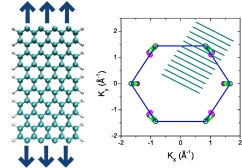We report on a theoretical study of charge transport properties of graphene nanoribbons under external mechanical stress. The influence of mechanical forces on the ribbon conductance is shown to be strongly dependent on the ribbon edge symmetry, i.e., zigzag versus armchair. In contrast to zigzag-edge nanoribbons which remain robust against high strain deformations, a stretching-induced metal-semiconductor transition is obtained for armchair-edge configurations. Our results point out that armchair edge ribbons are consequently much better suited for electromechanical applications.

We report on a theoretical study of charge transport properties of graphene nanoribbons under external mechanical stress. The influence of mechanical forces on the ribbon conductance is shown to be strongly dependent on the ribbon edge symmetry, i.e., zigzag versus armchair. In contrast to zigzag-edge nanoribbons which remain robust against high strain deformations, a stretching-induced metal-semiconductor transition is obtained for armchair-edge configurations. Our results point out that armchair edge ribbons are consequently much better suited for electromechanical applications.
